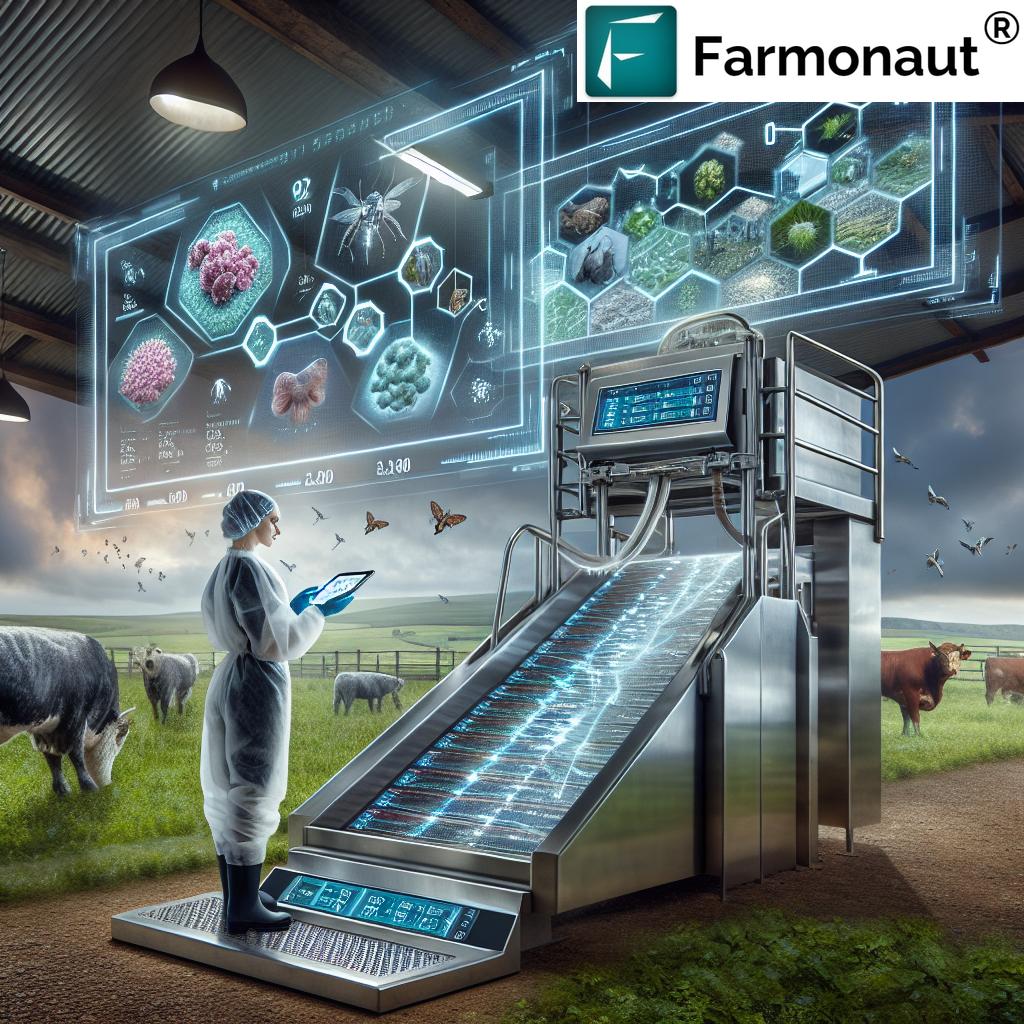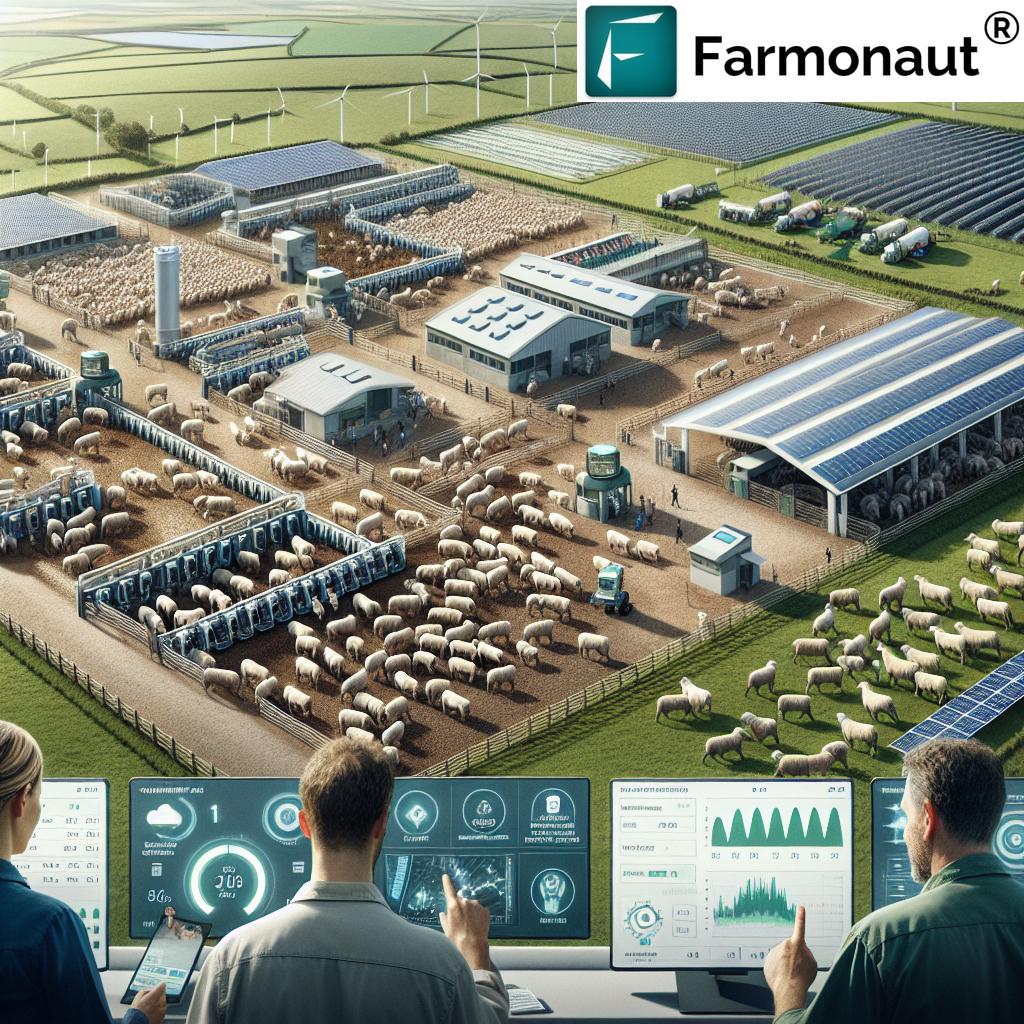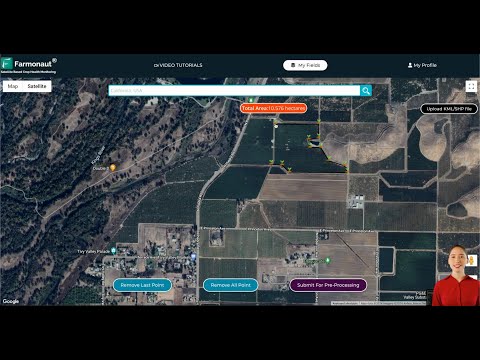Maximizing Farm Productivity: Farmonaut’s Guide to Accurate Anthelmintic Dosing for Livestock Health in the UK

“Electronic weighing systems can improve anthelmintic dosing accuracy by up to 95% compared to visual estimation methods.”
In the ever-evolving landscape of UK agriculture, we at Farmonaut understand the critical importance of livestock parasite management in maximizing farm productivity. As experts in agricultural technology and farm management solutions, we’re excited to share our comprehensive guide on accurate anthelmintic dosing for livestock health in the UK. This guide will explore how precision in medication administration can significantly impact farm productivity and animal health, leveraging innovative agricultural technology to revolutionize parasite control best practices.
The Importance of Accurate Anthelmintic Dosing
Accurate anthelmintic dosing is a cornerstone of effective livestock parasite management. In the UK’s diverse agricultural sector, from dairy farms in England to sheep holdings in Scotland, the proper administration of anthelmintics plays a crucial role in maintaining animal health, optimizing production, and ensuring the sustainability of farming operations.
- Improved animal health and welfare
- Enhanced farm productivity and profitability
- Reduced risk of anthelmintic resistance
- Minimized environmental impact
By implementing precise dosing strategies, UK farmers can significantly improve their livestock’s overall health, leading to increased productivity and better financial outcomes. This is particularly important in the face of changing market dynamics, export challenges, and the need for sustainable farming practices.
Understanding Anthelmintics and Their Role in Livestock Health
Anthelmintics are a class of drugs used to control parasitic worms in livestock. In the UK, where livestock farming is a significant contributor to the agricultural sector, these medications play a vital role in maintaining animal health and productivity. Common parasites affecting UK livestock include:
- Gastrointestinal nematodes
- Liver fluke
- Lungworms
Effective parasite control through accurate anthelmintic dosing is essential for:
- Optimizing feed conversion rates
- Improving growth rates in young stock
- Enhancing milk production in dairy cattle
- Maintaining wool quality in sheep
Factors Influencing Anthelmintic Dosage
Several factors impact the appropriate dosage of anthelmintics for livestock. Understanding these elements is crucial for UK farmers to implement effective parasite control programs:
- Animal weight: Accurate liveweight estimation is critical for correct dosing
- Parasite species: Different parasites may require varying dosages or specific anthelmintic classes
- Animal age and physiological state: Young animals or pregnant livestock may have different dosing requirements
- Environmental conditions: Seasonal variations can affect parasite prevalence and drug efficacy
- Farm management practices: Grazing strategies and housing conditions influence parasite exposure
To address these factors effectively, UK farmers can leverage agricultural technology and data-driven approaches to enhance their livestock parasite management strategies.
Innovative Technologies for Accurate Anthelmintic Dosing
At Farmonaut, we recognize the transformative power of agricultural technology in improving farm management practices. For accurate anthelmintic dosing, several innovative tools are revolutionizing the way UK farmers approach livestock parasite control:
- Electronic weighing systems: These provide precise weight measurements, crucial for accurate dosing
- Livestock medication dosage calculators: Digital tools that compute exact dosages based on animal weight and drug specifications
- Mobile apps for parasite management: Applications that help track treatment schedules and monitor efficacy
- RFID technology: Enables individual animal identification and treatment record-keeping
By integrating these technologies into their farm management strategies, UK farmers can significantly enhance the accuracy and efficiency of their anthelmintic dosing practices.
Implementing Effective Weighing Strategies for Livestock
Accurate weighing is the foundation of precise anthelmintic dosing. In the UK, where livestock farming encompasses a wide range of animals from dairy cattle to sheep, implementing effective weighing strategies is crucial. Here are some best practices:
- Regular weighing schedules: Establish routine weighing intervals to track growth and adjust dosages accordingly
- Calibration of weighing equipment: Ensure all scales and electronic systems are regularly calibrated for accuracy
- Group weighing techniques: For large herds or flocks, consider implementing group weighing methods to save time
- Mobile weighing solutions: Invest in portable weighing systems for convenient on-farm use
By prioritizing accurate weighing, UK farmers can significantly improve the efficacy of their anthelmintic treatments and overall herd health management.
The Role of Data in Optimizing Anthelmintic Use
In the era of precision agriculture, data plays a pivotal role in optimizing farm management practices, including anthelmintic use. At Farmonaut, we emphasize the importance of leveraging data for informed decision-making in livestock parasite management:
- Treatment records: Maintain detailed digital records of anthelmintic treatments, including dates, products used, and dosages
- Efficacy monitoring: Use data to track the effectiveness of treatments over time
- Parasite prevalence patterns: Analyze data to identify seasonal or environmental factors affecting parasite loads
- Resistance monitoring: Utilize data to detect early signs of anthelmintic resistance in parasite populations
By harnessing the power of data, UK farmers can develop more targeted and sustainable parasite control strategies, ultimately leading to improved farm productivity and animal health.
Sustainable Approaches to Parasite Control
While accurate anthelmintic dosing is crucial, it’s equally important to adopt sustainable approaches to parasite control. This is particularly relevant in the UK, where there’s growing emphasis on environmentally friendly farming practices. Consider these strategies:
- Targeted selective treatments: Apply anthelmintics only to animals that genuinely need treatment
- Pasture management: Implement rotational grazing to reduce parasite exposure
- Bioactive forages: Incorporate plants with natural anthelmintic properties into pastures
- Genetic selection: Breed for parasite resistance in livestock
By combining these sustainable approaches with precise anthelmintic dosing, UK farmers can create a more holistic and environmentally friendly parasite management program.

“Proper anthelmintic dosing can increase livestock productivity by 10-20% through improved parasite control and animal health.”
Economic Impact of Accurate Anthelmintic Dosing
The economic benefits of implementing accurate anthelmintic dosing strategies are significant for UK livestock farmers. By optimizing parasite control, farmers can expect:
- Increased productivity: Healthier animals lead to better growth rates and higher yields
- Reduced treatment costs: Precise dosing minimizes wastage and the need for repeated treatments
- Improved feed efficiency: Parasite-free animals utilize feed more effectively
- Enhanced product quality: Healthier livestock produce higher quality meat, milk, and wool
These economic advantages contribute to the overall sustainability and profitability of UK farms, especially in the face of market fluctuations and global competition.
Regulatory Considerations for Anthelmintic Use in the UK
UK farmers must navigate a complex regulatory landscape when it comes to anthelmintic use. Key considerations include:
- Prescription requirements: Many anthelmintics require veterinary prescription
- Withdrawal periods: Adherence to specified withdrawal times for meat and milk products
- Environmental regulations: Compliance with guidelines on the environmental impact of anthelmintics
- Record-keeping obligations: Maintenance of detailed treatment records as required by UK legislation
Staying informed about these regulatory requirements is crucial for UK farmers to ensure compliance and maintain the integrity of their livestock products.
Training and Education for Effective Anthelmintic Use
Continuous education and training are essential for UK farmers to stay updated on best practices in anthelmintic dosing and parasite management. Consider the following opportunities:
- Veterinary workshops: Attend sessions on the latest parasite control strategies
- Online courses: Enroll in digital learning programs focused on livestock health management
- Industry seminars: Participate in events discussing advancements in agricultural technology for animal health
- Peer learning groups: Join farmer networks to share experiences and best practices
By investing in ongoing education, UK farmers can enhance their skills in livestock parasite management and stay ahead of evolving challenges in the industry.
The Future of Anthelmintic Dosing and Parasite Control
As we look to the future of livestock farming in the UK, several emerging trends and technologies are set to shape anthelmintic dosing and parasite control practices:
- Precision livestock farming: Integration of sensors and IoT devices for real-time health monitoring
- AI-driven parasite prediction models: Advanced algorithms to forecast parasite outbreaks and optimize treatment timing
- Novel anthelmintic formulations: Development of new drug delivery systems for more effective and targeted treatments
- Genetic technologies: Advancements in breeding for parasite-resistant livestock strains
At Farmonaut, we’re committed to staying at the forefront of these developments, providing UK farmers with cutting-edge tools and insights to enhance their livestock parasite management strategies.
Comparative Analysis: Traditional vs. Technology-Assisted Anthelmintic Dosing
To illustrate the benefits of adopting technology-assisted methods for anthelmintic dosing, we’ve prepared a comprehensive comparison table:
| Aspect | Traditional Method | Technology-Assisted Method |
|---|---|---|
| Weighing Accuracy | Visual estimation, often inaccurate | Precise electronic weighing systems |
| Dosage Calculation | Manual calculation, prone to errors | Automated calculators with minimal error risk |
| Administration Precision | Variable, depends on operator skill | Consistent, guided by digital tools |
| Time Efficiency | Time-consuming process | Rapid, streamlined procedures |
| Risk of Underdosing | High, due to estimation errors | Low, thanks to precise measurements |
| Risk of Overdosing | Moderate to high | Minimal, controlled by accurate dosing tools |
| Data Recording | Manual, often incomplete | Automated, comprehensive digital records |
| Treatment Efficacy | Variable, often suboptimal | Consistently high due to precise dosing |
| Cost-Effectiveness | Lower initial cost, higher long-term expenses | Higher initial investment, better long-term ROI |
| Environmental Impact | Potentially higher due to overuse | Reduced, thanks to optimized drug use |
This comparison clearly demonstrates the advantages of adopting technology-assisted methods for anthelmintic dosing in UK livestock farming.
Integrating Farmonaut’s Solutions with Anthelmintic Dosing Strategies
At Farmonaut, we offer a range of tools and services that can complement and enhance your anthelmintic dosing strategies:
- Satellite-based farm monitoring: Use our advanced imagery to assess pasture conditions and potential parasite hotspots
- AI-powered advisory system: Receive tailored recommendations for optimal treatment timing based on environmental factors
- Data management tools: Utilize our platform to maintain comprehensive treatment records and analyze efficacy trends
- Mobile app integration: Access vital farm data on-the-go for informed decision-making in the field
By leveraging Farmonaut’s agricultural technology solutions, UK farmers can take their livestock parasite management to the next level, ensuring optimal health and productivity.
Explore our range of services:
Conclusion: Elevating UK Livestock Farming Through Precision Anthelmintic Dosing
As we’ve explored throughout this guide, accurate anthelmintic dosing is a critical component of successful livestock parasite management in the UK. By embracing innovative agricultural technology and data-driven approaches, farmers can significantly enhance their farm productivity, animal health, and overall operational efficiency.
Key takeaways include:
- The importance of precise weight measurement for correct dosing
- Leveraging technology for improved accuracy and record-keeping
- Adopting sustainable parasite control strategies
- Understanding the economic benefits of effective anthelmintic use
- Staying informed about regulatory requirements and future trends
At Farmonaut, we’re committed to supporting UK farmers in their journey towards more efficient and sustainable livestock management. By combining our cutting-edge agricultural technology solutions with best practices in anthelmintic dosing, we believe UK farms can achieve new levels of productivity and success.
We encourage you to explore our range of services and discover how Farmonaut can help transform your approach to livestock health and farm management. Together, we can build a more resilient and prosperous future for UK agriculture.
Frequently Asked Questions (FAQs)
Q1: How often should I weigh my livestock for accurate anthelmintic dosing?
A: Regular weighing is crucial for accurate dosing. For growing animals, monthly weighing is recommended, while adult animals may be weighed quarterly. However, always consult with your veterinarian for specific recommendations based on your herd or flock.
Q2: Can I use the same anthelmintic for all types of livestock?
A: No, different livestock species may require different anthelmintics. Always use products specifically approved for the species you’re treating and consult with your veterinarian for the most appropriate choices.
Q3: How can I minimize the risk of anthelmintic resistance in my herd?
A: To reduce the risk of resistance, implement targeted selective treatments, rotate between different anthelmintic classes, ensure accurate dosing, and integrate non-chemical parasite control methods into your management strategy.
Q4: Are there any natural alternatives to chemical anthelmintics?
A: While chemical anthelmintics are often the most effective, some natural alternatives include bioactive forages (e.g., chicory, birdsfoot trefoil), good pasture management, and breeding for parasite resistance. These should be used as part of an integrated parasite management approach.
Q5: How can Farmonaut’s technology help with my livestock parasite management?
A: Farmonaut’s satellite-based monitoring and AI-powered advisory systems can help you identify potential parasite hotspots, optimize treatment timing, and maintain comprehensive digital records of your parasite control efforts, enhancing the overall efficacy of your management strategy.






